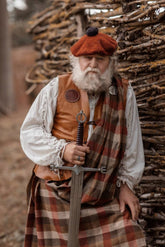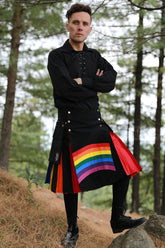William Wallace: His Life, Achievements, & Braveheart Legacy!
Who Was William Wallace?
William Wallace, also known as "Willie Wallace," emerged as a pivotal force in the First War of Scottish Independence against England. Born around 1270 in Elderslie, Renfrewshire, Scotland, Wallace is celebrated for his leadership in securing a remarkable victory for the Scots against a larger English army at the Battle of Stirling Bridge in September 1297. Wallace served as the guardian during the early years of the struggle for Scotland's independence from English rule. His legacy is etched in the triumphs of that historic battle and his commitment to Scotland's quest for freedom. Despite his ultimate capture and brutal execution, he became a martyr and a legendary figure, inspiring countless tales, ballads, and poems. His legacy as a courageous patriot endures, and he is widely regarded as one of Scotland's greatest heroes. Wallace's leadership and sacrifice have cemented his place in history as a symbol of the ongoing Scottish quest for independence.

His Early Life and Tragedy:
He was born in Elderslie, Renfrewshire, Scotland, in the 1270s, to Sir Malcolm Wallace, a Scottish landowner. His early education was under his clergyman uncles in Dunipace near Stirling, and he later completed studies in Dundee. Tragedy struck with his father's death in 1291, which fueled Wallace's determination to fight for Scotland's independence. Wallace became an outlaw, possibly due to involvement in an Englishman's death, which set the stage for ongoing conflict with English forces. Wallace's lifelong commitment to Scotland's independence was ignited by losing his father, emphasizing the personal and emotional motivations behind his role in the quest for freedom. His capture and execution in 1305 made him a martyr and a symbol of the struggle for Scottish independence.
Challenges William Wallace Faced:
William Wallace, the hero of Clan Wallace and Braveheart History, faced numerous challenges during his life. One of the main difficulties he faced was not the English, but his fellow Scots. Many Scottish nobles placed their self-interest first and refused to cooperate with Wallace or join his grand national vision. He raised a following, but very few of the leading nobility took up his challenge. The divisions within the ranks of Scottish nobility went deep, and many refused to follow a commoner like Wallace, and many had stronger ties to England than to Scotland. Moreover, Wallace's life unfolded in a complex era marked by shifting alliances, political intrigue, and societal upheaval. His actions and decisions were deeply influenced by the historical context of the time. Despite these challenges, Wallace exemplified leadership through innate qualities and unwavering determination. His story is a testament to the impact of qualities like determination and resilience in the face of adversity.
His Contributions and Battles:
He was a Scottish hero who played a crucial role in the fight for Scottish independence. Partnered with Andrew de Moray, he achieved a significant victory at the Battle of Stirling Bridge in September 1297, defeating a much larger English army and resulting in approximately 5,000 English soldiers dead on the field. This triumph led to Wallace's appointment as the Guardian of Scotland. However, he faced defeat at the Battle of Falkirk in July 1298 and was later captured and executed for high treason. Despite this, Wallace's legacy extends beyond his homeland, making him a symbol of Scottish resistance and patriotism. He has been immortalized in literature, particularly in the 15th-century epic poem "The Wallace," and cinematically in the movie "Braveheart." Wallace's leadership and military prowess continue to inspire generations.

Robert the Bruce's Relationship with Wallace:
Robert the Bruce's relationship with William Wallace was complex and marked by shifting allegiances, While there is no evidence that the two ever met. In the movie, the dramatic betrayal of Wallace by Bruce is an artistic license. In reality, Bruce publicly disowned Wallace initially but later supported the war effort, showing the complexity of their relationship. Bruce's early support for Wallace shifted when he marched with the English against Scotland in 1297, but he later played a crucial role in the fight for Scottish independence. The true nature of their relationship is not as harmonious as often portrayed in historical romance, reflecting the complexities of patriotism in 14th-century Scotland. This intricate dynamic between two of Scotland's iconic figures adds depth to the narrative of the country's struggle for independence.
Later Events and Legacy of His Life:
The later events and legacy of William's life are marked by significant historical moments. The Battle of Bannockburn in 1314 was a defining moment in Scottish history, where Scotland achieved a significant victory over the English forces. Additionally, the Declaration of Arbroath in 1320 asserted Scotland's right to self-determination, laying the groundwork for the country's independence movement. Despite his tragic death in 1305, Wallace's legacy endured, and he became a symbol of Scottish independence. His heroic actions and leadership inspired future generations and contributed to the eventual independence of Scotland under the rule of Robert the Bruce. The life of him continues to be celebrated and commemorated as a pivotal chapter in Scottish history.
Legacy of the Wallace Clan Tartan!
The legacy of the Wallace Clan Tartans is a vibrant tapestry that symbolizes Scottish history and honors the spirit of Sir William Wallace, who played a significant role in the Wars of Scottish Independence. With distinctive stripes mirroring Scotland's landscape, the Wallace Tartan represents the nation's resilience and embodies core Scottish values, uniting the past and present as a source of national pride. However, the complexity arises from multiple tartans being linked to a single clan, posing a challenge for individuals in selecting their specific clan tartan. From the Wallace Modern to the Wallace Hunting, each tartan carries a unique history and significance, reflecting the enduring impact of the Wallace Clan on Scottish heritage and beyond.
Wallace Clan History:
The Wallace Clan is a Lowlands Scottish Clan that originated as Strathclyde Britons in the ancient Kingdom of Strathclyde. The first recorded member of the clan was Richard Walensis around 1165, who witnessed a charter by Alan, son of Walter the High Steward of Scotland. The clan is descended from William Wallace, the Scottish freedom fighter, and his lineage is linked to the Wallaces of Craigie, Ayrshire. The clan's motto is "Pro libertate" (For Liberty), and its crest features a crested coronet, an armored dexter arm holding a sword. Captain Henry Wallace was acknowledged as Chief in 1888, and the current Chief is Ian Francis Wallace. Notable figures include Robert Wallace, Sir Donald Mackenzie Wallace, Composer William Wallace, and Henry Agard Wallace.
Name Wallace: Meaning and Origin!
Wallace is a Scottish surname that combines Welsh and Scottish origins dating back to the 12th century. The name "Wallace" originates from "Walensis," indicating cultural ties to Wales and Strathclyde. Sir William Wallace's notable stand against English rule, particularly at the Battle of Stirling Bridge, sparks Scottish rebellion. Despite challenges, Wallace's legacy perseveres, influencing Scotland's culture and politics. The name symbolizes lineage, collective identity, and historical movements, epitomizing Scotland's spirit. The Wallace Clan's narrative resonates through generations, serving as a testament to bravery and enduring influence. The name "Wallace" is deeply connected to history, cultural value, and unity. It is a boy's name of Scottish, English origin meaning "foreigner, stranger" and is ranked 966 in popularity.
William Wallace Family Tree:
The Wallace Family Tree is a fascinating genealogical study of the descendants of William Wallace, the Scottish knight who became one of the main leaders during the Wars of Scottish Independence. While there is no evidence that he had any children or direct descendants, his legacy lives on through his strategic prowess in the Battle of Stirling Bridge in 1297, which is notably linked to Stirling, and the Battle of Rosslyn in 1303, which took place in Roslin Glen Country Park. Dryburgh, known for its abbey, erected the first memorial honoring Wallace in 1814, and Scott’s View provides breathtaking vistas over the Eildon Hills. Lanark Museum offers insights into the ties between the town and Wallace, with a legend stating that Wallace wed his spouse Marion Braidfute in St Kentigern’s Church. Riccarton, Ayrshire, dating back to approximately 1160, serves as the ancestral abode of the Wallace clan.
When is William Wallace’s Day celebrated?
William Wallace Day is celebrated on August 23rd. This day honors the Scottish knight who led a famous uprising against English rule in the late 13th century. He was executed for treason on August 23, 1305, after being captured by the English. His heroic struggle has been immortalized in history and popular culture, inspiring the epic film "Braveheart," which brought his story to a global audience. The significance of this day is reflected in the campaign to adopt August 23 as a National Wallace Day in Scotland.
The Movie "Braveheart"
"Braveheart" is a 1995 historical drama directed by Mel Gibson, depicting the story of Scottish hero William Wallace resisting English rule in the late 13th century. The movie features notable actors, including Mel Gibson, Sophie Marceau, Patrick McGoohan, and Catherine McCormack. A specific tartan was designed for the film's costumes, known as the Braveheart Tartan, which has since become a symbol of Scottish pride and rebellion. The film's musical score, composed by James Horner, is widely acclaimed as one of the best film scores of all time. "Braveheart" explores themes of freedom, rebellion, and Scottish identity, contributing to its lasting cultural impact and popularity. Despite playing fast and loose with historical facts, the movie still entertains and engages with the full force of a Hollywood blockbuster. "Braveheart" was released in 1995 and won five Academy Awards, including Best Picture.

Braveheart Tartan & their Clan:
The Braveheart Tartan is a highly recognizable and enduring symbol of Scottish heritage and pride, with a unique color scheme representing the Scottish landscape and rebellion against England. The tartan was designed for the 1995 movie "Braveheart," featuring blue and green colors for the Scottish landscape and red stripes representing rebellion against England. The Tartan is inspired by Scottish hero William Wallace and holds significant cultural value in Scottish tradition. Although not an official clan tartan, the Braveheart Tartan has become popular among those who admire William Wallace and the Scottish independence movement. The tartan has a rich history dating back centuries and a unique blend of colors and patterns incorporated into various products, such as kilts, jackets, and accessories. The Braveheart Tartan remains popular for honoring Scottish heritage and William Wallace's legacy.
Tartan Usage and Significance!
Tartan is a type of fabric that is woven with different colored threads in a specific pattern. It is a symbol of Scottish identity and cultural heritage, tracing its significance back to Scotland's history of tartan patterns. The Braveheart Tartan, which originated in the Scottish Highlands, has gained iconic status as a symbol of Scotland and is linked to the Braveheart Clan. The tartan is characterized by a bold design and carries rich symbolism, contributing to its beloved status in Scottish culture.
Today, the Braveheart Tartan is worn in diverse settings like weddings, formal events, and traditional ceremonies, and used in various products such as kilts, jackets, and accessories. Wearing this tartan is a means of connecting with Scottish heritage and serves as a tribute to one's ancestry.
Looking for the Exclusive Wallace or Braveheart Tartan Kilt?
If you're in search of the exclusive Wallace or Braveheart tartan kilt, Fashion Kilt offers a wide selection of high-quality men's kilts, allowing you to choose the tartan of your choice. Whether it's the iconic Wallace tartan or the timeless Braveheart tartan, you can personalize your kilt to suit your style. Our craftsmanship and attention to detail ensure a premium product that embodies tradition and sophistication. Embrace the heritage of Scottish kilts with a modern twist by selecting your preferred tartan from our collection. Elevate your wardrobe with a bespoke kilt that reflects your individuality and pays homage to Scottish heritage.
FAQs
What is the Society of William Wallace?
The Society of William Wallace is a Scottish Charitable Incorporated Organisation that aims to promote the life and legacy of William.
What is the significance of the phrase "Alba gu Bràth"?
In the movie Braveheart, William Wallace shouts "Alba gu Bràth" as he gallops across the front of his assembled Scottish army. It translates into English as 'Scotland forever'.
What is the historical accuracy of the movie Braveheart?
The movie Braveheart has been criticized by many historians for taking creative liberties with the plot. However, it generated huge interest in Scotland and its history and has even been accused of driving tourism to the country.
What is the Braveheart tartan?
The Braveheart tartan is a joint design between Charles Knode, costume designer of the Shepperton Studios, and Gordon Cavell of the Islay Woollen Mill for Mel Gibson's 1995 Braveheart extraordinaire.
Did William Wallace wear a kilt?
No, William Wallace did not wear a kilt. Kilts were not invented until the 16th century, while he lived in the late 13th and early 14th centuries. Before kilts, the people of Scotland wore a long shirt-like tunic called the léine.














